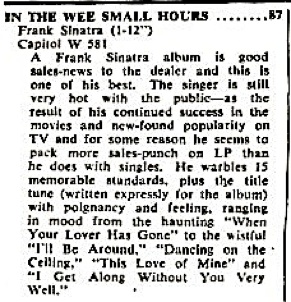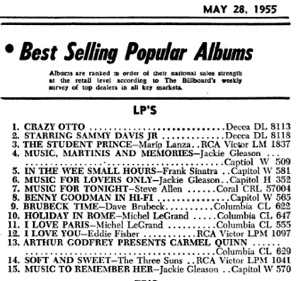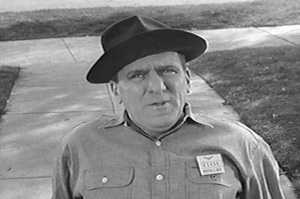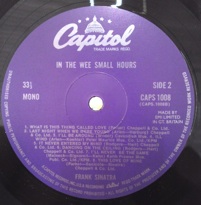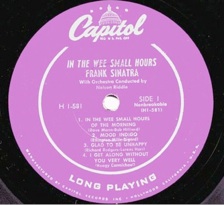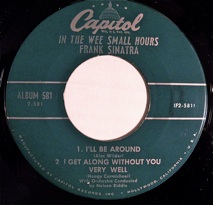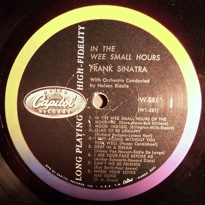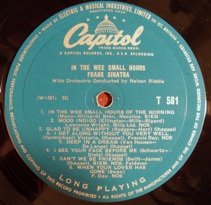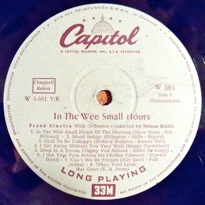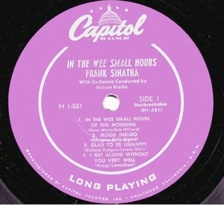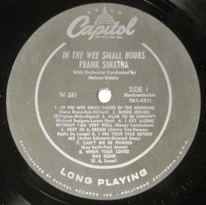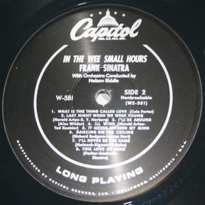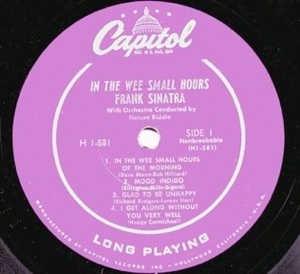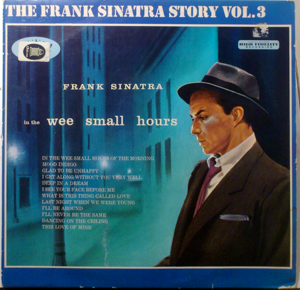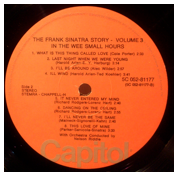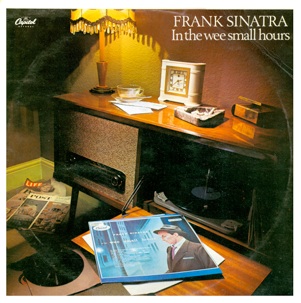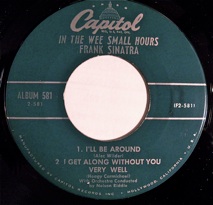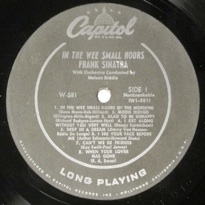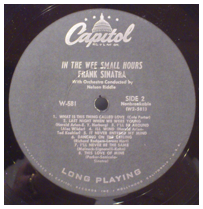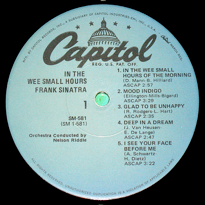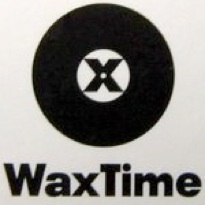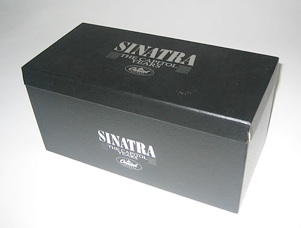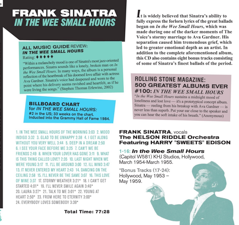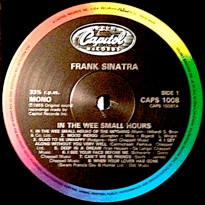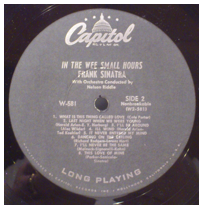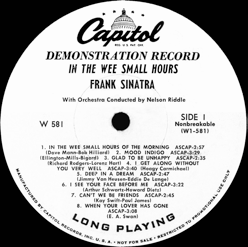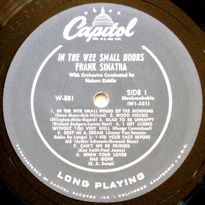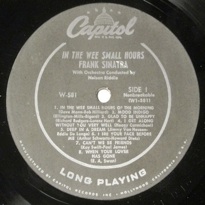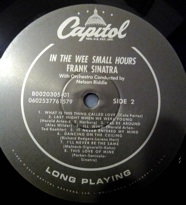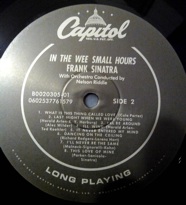In the wee small hours - 1955


In the Wee Small Hours has been my favorite album for almost as long as I can remember. I first discovered the album -- in 10” form, no less -- in elementary school. Now, I’m old enough to have grown kids of my own, yet when somebody asks what my favorite album is by any artist, my immediate and sincere answer remains In the Wee Small Hours by Frank Sinatra. After literally hundreds of listens, it still comes across as fresh, vibrant, and heartfelt.
I suspect that Mr. Sinatra was inspired to do this album -- lonely, yet not full of despair -- after recording “Last Night When We Were Young” with Nelson Riddle in the spring of 1954, and that after completing that recording he thought to himself: The mood of that song is too pure for a single; too painful to be on an album of light music. It needed to be a centerpiece for something more grand in scope, and so it sat for a year until it could be properly fleshed out with other songs of similar style and mood, part of a lengthy album that, to me at least, comes across as 100% note-perfect, graceful, elegant, and honest.
Others may argue, but I submit to you that In the Wee Small Hours was not designed as a 12” album, but rather as a double 10” set. Admittedly, this is how I first knew the album, but to my ears, I Get Along Without You Very Well, When Your Lover Has Gone, Ill Wind, and This Love of Mine all play like side-closers, while the title tune, Deep in a Dream, What is this Thing Called Love, and It Never Entered My Mind all act as places where we pick up the action in an ongoing performance. In fact, I would say that each 4-song, 10” side is themed:
Side One:
•In the Wee Small Hours of the Morning
•Mood Indigo Another lonely night, still awake, thinking about her.
•Glad to Be unhappy
•I Get Along Without You Very Well
Side Two:
•Deep in a Dream “I’m Deep in a Dream of You.”
•I See Your Face Before Me “...haunting my every dream.”
•Can’t We Be Friends “I thought I’d found the girl of my dreams...”
•When Your Lover Has Gone “What good is the dreaming, the planning, and scheming....”
Side Three:
•What Is This Thing Called Love?
•Last Night When We Were Young Tossing, turning, reliving
•I’ll Be Around
•Ill Wind (Key line: “Let me rest today.”)
Side Four:
•It Never Entered My Mind
•Dancing on the Ceiling In and out of sleep, dreams finally giving way to morning and resignation
•I’ll Never Be the Same
•This Love of Mine
A personal favorite
We’ll likely never know which version was “the real” release. From this LP on, every LP would be of the 12” variety. Prior to this, all the Capitol Sinatra LPs were of the 10” variety.
Looking at the albums that were in the charts when In the Wee Small Hours hit, we see the following from Capitol:
•Jackie Gleason’s Music, Martinis, and Memories, which was available as a 12” 16-song LP, or as a 10” double-LP, 8 songs each. (Sound familiar? This album, by the way, was such a huge seller that it was re-recorded in stereo several years later.)
•Gleason’s Music for Lovers Only was a 10”-only release.
•Benny Goodman’s fantastic B.G. in Hi-Fi was available as a 12”, 16-song LP, or as a 10” double-LP, 8 songs each. (Again, sound familiar?)
•Jackie Gleason’s Music to Remember Her, which was available as a 12”, 16-song LP, or as a 10” double-LP, 8 songs each. (See a trend?)
All albums were also available in a 7” EP configuration.
Whichever way the album may have been conceived originally, promotional materials of the day featured the 12”, W-581 catalog number, so Capitol appeared to be promoting that format more consistently.
Click Billboard articles to be taken to on-line archive.

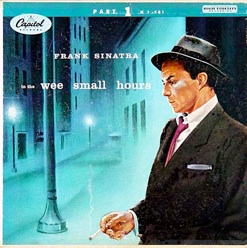
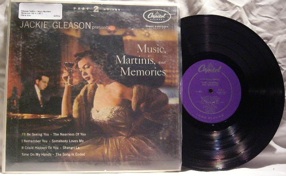
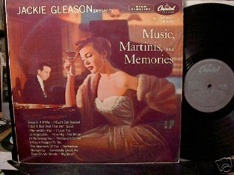
<-------
10”, part 2
------>
12”
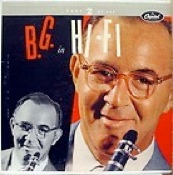
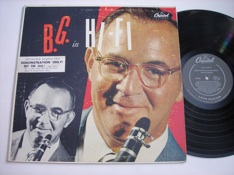
<-------
10”, part 2
------>
12”
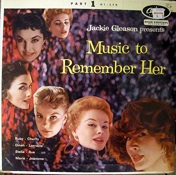
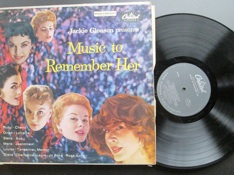
<-------
10”, part 1
------>
12”
“What a revoltin’ development this is!”
The messy release history of In the Wee Small Hours
1955 - 12”, 10”, 7” -- all versions contain 16 songs, as intended, sourced from correct tapes or dupes thereof
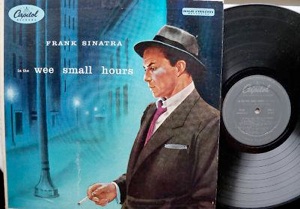
1962 -- two abridged versions appear, cut from 16 songs to 12. One version is still mono, maintaining the W-581 catalog number, but with tampered tapes, while the other, #DW-581 (later #DT-581), is in Capitol’s DUOPHONIC process. Note the addition of the song titles to the front cover.
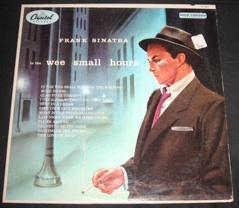
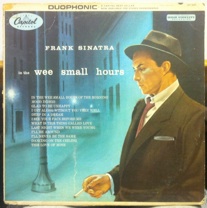
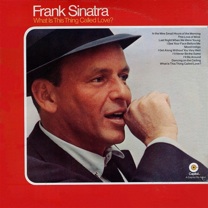
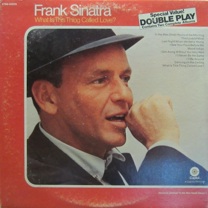
1970 -- Trimmed further to only 10 songs, Duophonic only, and sold as part of a 2-LP package, combined with an abridged, retitled, jumbled version of the Where Are You album. The 2-LP set was known as What Is this Thing Called Love?/The Night We Called It a Day.
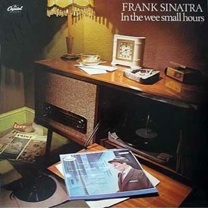
1970’s -- This U.K. release finally restored the album to its original 16-track length, but initial pressings used the Duophonic tapes summed to mono. (Later pressings reverted to the correct, mono tapes.) The alternate cover is quite charming on its own terms, but note that the “original LP artwork” that is featured as an element of the new artwork is the abridged, 12-song version! The rear cover, showing downtown San Diego at dusk, is odd, to put it mildly.
1970s -- The earlier “Double Play” 2-LP release is issued as a stand-alone, 10-song, Duophonic release. (Released under at least three different catalog numbers. Beware.)
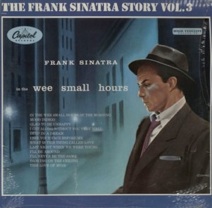
1978 -- Another return of the 16-track album, this time via EMI’s Holland branch. Sadly, the cover is adapted from the 12-song version, and the sound is Duophonic.


Early 1980s? -- The original cover returns as catalog #SM-581, which is also a true mono release. Again, only ten songs are used, but the song selection is not the same as on the previous 10-song incarnations. Note that beneath the Capitol logo is the legend, “A Capitol Monophonic Re-Issue.”
1983 -- The Mobile Fidelity audiophile treatment, one of the great missed opportunities in the Sinatra catalog. Sound quality is inconsistent, and two songs, “Mood Indigo” and “Glad to Be Unhappy,” flat-out used the wrong (circa 1962 reverb-added) “master” tapes. On the plus side, it did have all 16 songs, it was true mono, and some songs sounded very nice. A disappointment.
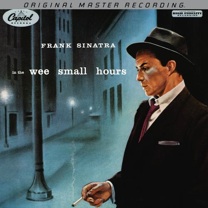
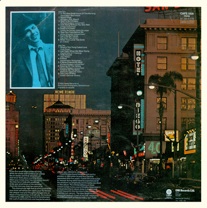
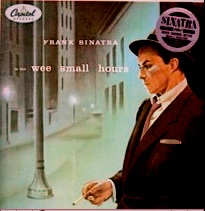
1984 -- The digitally-remastered UK (non-DMM) and Dutch (DMM) release in the “Alan Dell” reissue series of LPs. Again, it’s 16 songs, and again, it’s mono, but again, it uses wrong tapes. Yet another missed opportunity for greatness. The 1970s UK issue with the alternate cover was catalog #CAPS-1008, and for some reason, that catalog number was retained for this issue in the UK. To further confuse things, the EMI inner sleeves that promoted the Alan Dell releases depicted the alternate cover when referring to this 1984 release.
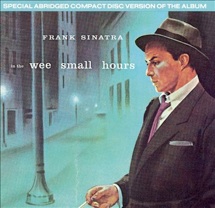
1986 - initial CD release, mastered by Larry Walsh. Abridged to 15 tracks due to current Capitol policy (see here). Correct session tapes were used, but stereo reverb was added. Yet again, a disappointment.
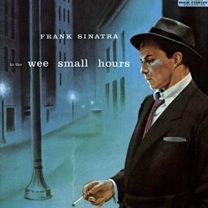
1991 - revised CD release, mastered by Larry Walsh. Same mastering situation as above, but with all 16 tracks present and accounted for.

1998 - “Entertainer of the Century” CD, remastered by Bob Norberg. “16 Tracks of Whack.”

1998 - “The Capitol Years” 21-CD UK boxed set. 16 tracks, true mono, from the proper tapes. Finally!
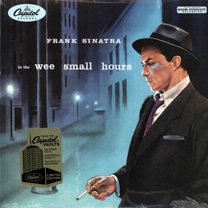
2009 - Capitol’s “From the Vaults” LP, featuring “audiophile mastering.” Incorrect, reverb-added tapes were used, and on the first run of disks, the last song on side one was from a different album altogether. Oops.
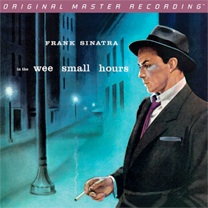
2014/2015 - Long-promised release from MFSL. Hopefully they will learn from the wealth of problems suffered by this classic title through the years. Fingers crossed....
UPDATE: Apparently this release, initially announced around Dec. 5, 2012, has been cancelled as of Nov. 15, 2013.

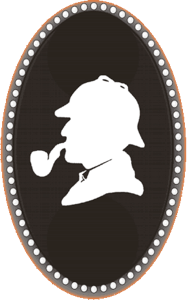


The Strange Case of the 1983 Mobile Fidelity LP

As outlined above, this LP has been tinkered with and abridged and reissued in multiple configurations since 1955, so it’s easy to see how true, original (session) tapes may have been misplaced over the years. That being the case, it’s still a little baffling in terms of precisely what went wrong with the 1983 MFSL LP.
SAMPLE AUDIO CLIPS
All clips posted here (with one 3-second exception) mirror those freely available via iTunes. To access the 90-second iTunes free samples, click
“View,” then “View in iTunes.”

Things start off in relatively promising fashion on the title track, with dry tapes, and generally good tone. A bit of background: When we first looked at this album in 2009, one of the best-sounding releases was the 1998 UK boxed-set CD. Using that well-regarded version as a standard (of sorts), let’s listen to a clip from the UK CD, transitioning into the MFSL LP. Click here: WSH UK98-MFSL83-NORM_01.wav While the CD definitely has more high frequency content, at least we can say that both versions use tapes that have no reverb added, even if the 1983 MFSL LP has no sparkle by comparison.
Track two, Mood Indigo, is much more confounding, as now we start with “dry” tapes on the UK CD, move to tapes that are clearly compressed with reverb added on the MFSL LP, then back again to the UK CD. Click here: MoodIndigoUK98-MFSL83-UK98.wav
Track three, Glad to Be Unhappy, follows in a similar vein. In the clip that follows, you will hear 1.) UK CD; 2.) 1983 MFSl LP; 3.) UK CD again. Click here: Glad to Be Unhappy UK98-NORM_01-03.wav
Track four, I Get Along Without You Very Well, goes back to the situation we found on the title track, i.e., rolled off treble and lack of sparkle. The next clip unfolds like this: 1.) Briefly, the UK CD; 2.) at “But I get,” the MFSL 1983 LP; 3.) at “I’ve forgotten,” the UK CD; and 4.) at “except to hear,” the MFSL LP again. Click here: IGetAlongUK09-MFSL83-UK98-MFSL83.wav
At track five, Deep in a Dream, something odd starts to happen: The MFSL loses some of its muffled quality. Here is a brief clip, in this order: UK CD, MFSL LP, UK CD, MFSL LP. Click here: DeepInADreamUK98-MFSL83-UK98-MFSL83.aif The MFSL does not have as much high-frequency content as the UK CD (which may be a bit thin sounding in spots), but it’s in the ballpark now.
SAMPLE AUDIO CLIPS
All clips posted here (with one 3-second exception) mirror those freely available via iTunes. To access the 90-second iTunes free samples, click
“View,” then “View in iTunes.”

At track six, I See Your Face Before Me, things sound very nice, perhaps (?) even fully copacetic. Here is a brief clip, with no transition this time. Rather, this is the same segment, first from the 1983 MFSL LP, then from the 1998 UK CD. Click here: ISeeYourFaceMFSL83-UK98.wav
Track seven, Can’t We Be Friends, finds the 1983 MFSL back in Dullsville. Listen intently, please, for two things in the clip that follows: 1.) the tone of the guitar on the opening strum; and 2.) the gentle brushstrokes on the ride cymbal in the background. The clip starts with the UK CD, then switches to the 1983 MFSL LP. Click here: CantWeBeFriendsUK98-MFSL83.aif (As an aside, you know what this reminds me of? The difference between the UK CD, which has clear, open cymbal tone, and the 2013 MFSL CD, where it’s comparatively rolled off, on Sinatra’s Swingin’ Session.)

Heretic! Out you go!
Track eight, Deep in a Dream, is very simlar, lacking sparkle, laying flat. Listen to the interplay between the harp and glockenspiel, MFSL ’83 first, UK CD second. Click here: GlockenharpMFSL83-UK98.aif
Track nine (start of the 12” LP’s side two), What Is This Thing Called Love, has perhaps the best sound thus far on the 1983 MFSL LP. While still having a hair less treble than the UK CD, I think we can perhaps just chalk this up to differences in mastering tastes, not to any sort of scandal involving which tapes were used. For instance, what follows is a brief comparison of the drum sound, MFSL first, UK CD second. Click here: WhatIsThisDrumMFSL83-UK98.wav By and large, however, the two tracks sound quite similar, as evidenced by the following quick clip, MFSL first, UK CD second. Click here: WhatIsThisMFSL83-UK98.wav
SAMPLE AUDIO CLIPS
All clips posted here (with one 3-second exception) mirror those freely available via iTunes. To access the 90-second iTunes free samples, click
“View,” then “View in iTunes.”

Track ten, Last Night When We Were Young, sounds just a little dull on the MFSL LP, but it’s “Dry” and dynamic.
Track 11, I’ll Be Around, has a faded up opening on the MFSL LP. (I seem to recall this happening on another edition of the album, as well, but can’t place it. Anybody know?) Let’s hear the un-faded UK CD clip, followed by the faded-up MFSL 1983 clip. Click here: CelesteUK98-MFSL83.aif Aside from that problem, this track sounds very good.
From this point on, the LP continues with that “no sparkle” sound, with a dull, un-vibrant top-end and no “umph,” despite being (in terms of waveforms) very dynamic and properly “dry.”
Something clearly went awry in 1983.

The Strange Case of the Norberg CD and its Relationship to the 1983 MFSL LP
SHTV member “MMM” brought to my attention the fact that there are some apparent similarities between the 1983 MFSL LP and the Norberg-remastered “Entertainer of the Century” CD, and, indeed, there are similarities.
[NOTE: as we compare waveforms, keep in mind that the Norberg tracks involve some degree of “fake stereo” processing. All waveforms for Norberg samples show the left channel only. The true, original tapes are, of course, monophonic, as is the 1983 MFSL LP.]
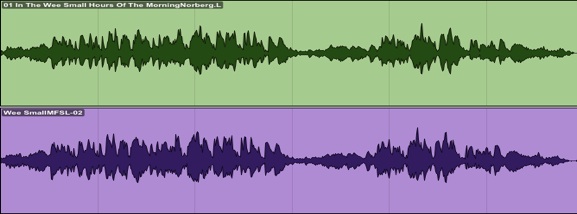
At right are waveforms from the album’s title track, Norberg in green, 1983 MFSL LP in purple. Both sonically and visually, these seem to be potentially derived from the same source tape or a dupe thereof. (Remember: cut the Norberg waveform a little slack, as we are looking at half of a processed-for-stereo mono recording.) Both releases are appropriately “dry.”
* * * *
Next, we come to “Mood Indigo,” one of the perplexingly mis-sourced tracks on the 1983 MFSL LP, where it appears in wet and compressed form for some reason. Sonically and visually, the source appears to be the same on the Norberg CD. See waveforms at right, Norberg in green, 1983 MFSL LP in purple, as before.
* * * *
The other mis-sourced track on the 1983 MFSL LP was track three, “Glad to Be Unhappy,” which is compressed and “wet” on the MFSL. On the Norberg, however, the track lacks the MFSL disk’s compression, as we can see from the waveforms at right, while retaining the “wet” characteristic. After two tracks that seemed to mirror each other on both discs, now we have an apparent parting of ways, at least where dynamics are concerned.
* * * *
For track four, “I Get Along Without You Very Well,” we are back to the same scenario we had at track one, specifically: Dry tapes, and similar waveforms on the Norberg vis-a-vis the 1983 MFSL, but then on track 5, “Deep in a Dream,” the Norberg CD’s waveforms show flipped polarity compared to the 1983 MFSL LP. See waveforms at right.
* * * *
For tracks six through twelve, the waveforms, along with the actual sound characteristics, seem to once again imply that each comes from a similar source tape. Note, however, that on “I’ll Be Around,” the MFSL has that oddball fade-up in the opening, while the Norberg has the standard, non-faded opening notes. On track thirteen, “It Never Entered My Mind,” we again have a flipped polarity situation. See waveforms at right.

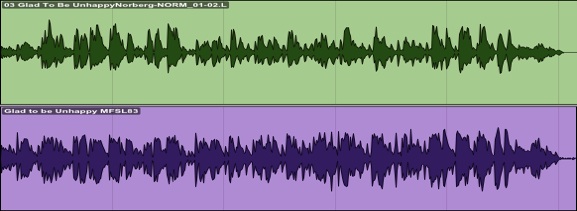
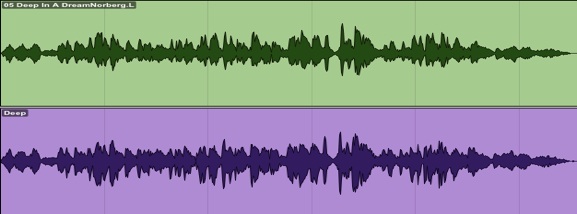
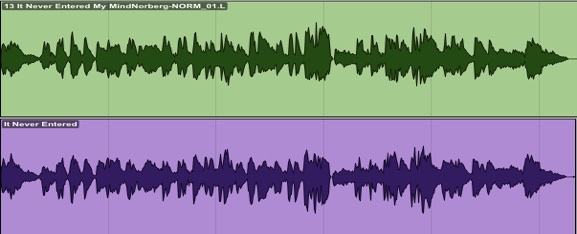
At the end of the discs, track 14 has shared, common polarity, track 15 is flipped, and track 16 has common polarity.
Waveforms and dynamics and wetness and dryness aside, there’s one other thing that makes me think that these two releases are attached at the hip, and that’s the odd way that “S” sounds sound, like they are trying to push their way through, but something is just not quite right. Maybe it’s the type of tape machine used for the transfer; maybe it’s an azimuth problem -- I don’t know. It’s certainly odd, though, that track two has the same “mess up” on both versions, that the tone is so dead and flat on so many of the tracks, and that the “s” sounds are as they are (not good).
I would be remiss were I not to mention that some tracks exhibit tape damage on the Norberg version that is not audible on the 1983 MFSL LP, but since the masterings were 15 years apart, it’s possible, I suppose, that the damage occurred during the intervening years.

The Strange Case of the 1970s “Alternate Cover” LPs


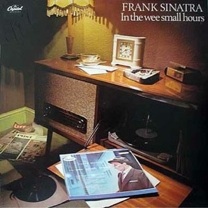
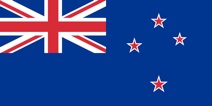
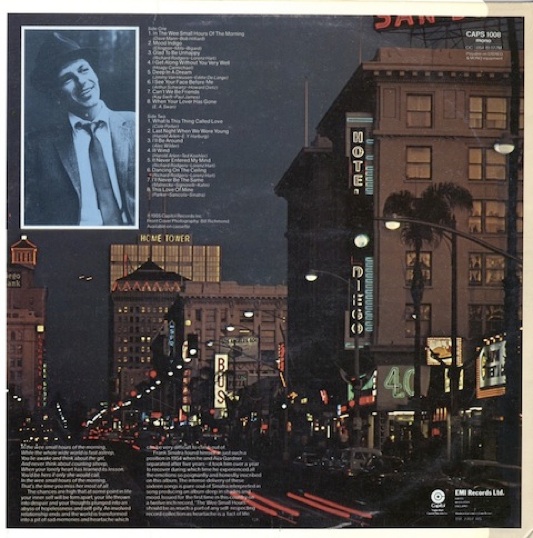
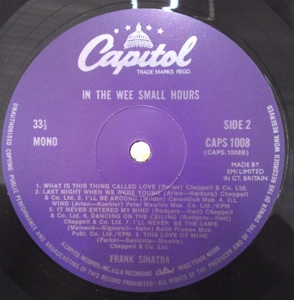
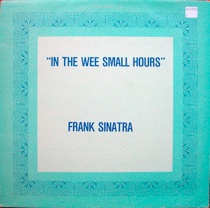

In the 1970s, EMI re-released In the Wee Small Hours on LP in the UK, New Zealand, and possibly elsewhere. All sixteen songs were present, and the LPs were mono...or were they? Initial pressings, specifically those that bore “-1” matrices on both sides, were technically mono, but they were cut from Duophonic source tapes that had been summed to mono, and sounded horrible. By the time of the “-2” pressings, somebody figured out that using the Duophonic tapes was a bad idea, and these later pressings used authentic mono tapes, with excellent tone and fidelity, with lacquers cut by none other than Harry Moss, famous for so many excellent Beatles lacquers, including the original Sgt. Pepper with the 15kHz tone and continuous runout track. Here is a clip that starts with the summed-from-Duophonic -1 cut, then transitions to the true-mono -2 cut (courtesy SH.TV member “William Shears): UK Icky-NZNotIcky.mp3
These 1970s EMI pressings are of excellent quality, but to make sure you don’t get stuck with a summed, Duophonic mess of an LP, you must look at the deadwax area and avoid any cuts that are “-1.” It would appear that any cuts that are -2 or later use the correct tapes. Oddly, my British copy (left photos, above) is identical to William Shears’ New Zealand copy (right photos, above) as far as the pressing goes: Both are -2 on side one, and -4 on side two, both cut by Harry Moss (“HPM” in the deadwax) at EMI in London.
CATALOG NUMBERS:
The New Zealand “World Record Club” release is catalog #WC 2299. That’s simple enough. The UK copies are a little more confusing where numbering is concerned. The Catalog number is #CAPS 1008. Not only do you have to make sure that you are getting the proper “cut” by checking the deadwax, you also need to be careful that you don’t wind up with a copy of the 1984 “Dell” series reissue LP, which reverted to the original cover, used the wrong “wet” tapes (reverb-added), but retained the #CAPS 1008 catalog number. If you are buying a UK copy, if you are not careful, it’s certainly possible to wind up with a poor-quality copy.
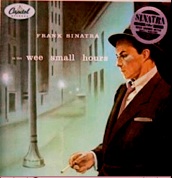
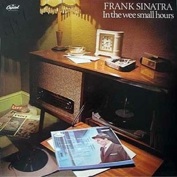
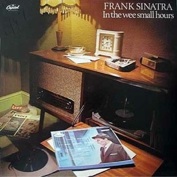
#CAPS 1008, -1 in deadwax: Duophonic tapes, summed to mono. AVOID.
#CAPS 1008, -2 or later in deadwax: Should be excellent, based on the -2/-4 cuts.
#CAPS 1008, “wet” reverb-added tapes. AVOID.
For 1970s/1980s UK LPs, here’s a summary:
Thanks to “William Shears” for his invaluable assistance with this section.
SAMPLE AUDIO CLIPS
All clips posted here (with one 3-second exception) mirror those freely available via iTunes. To access the 90-second iTunes free samples, click
“View,” then “View in iTunes.”

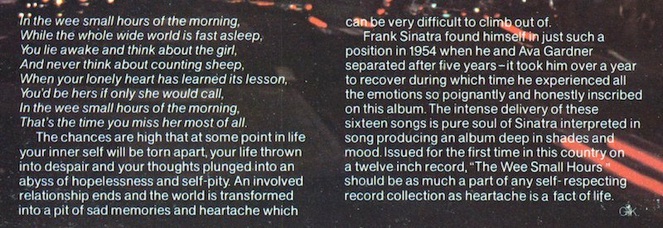
Rear cover notes, UK edition:
“I’ll Be Around”
This is a track from the “small group” session, led/conducted from the keyboard by Bill Miller in Nelson Riddle’s absence.
LP Comparisons
SAMPLE AUDIO CLIPS
All clips posted here (with one 3-second exception) mirror those freely available via iTunes. To access the 90-second iTunes free samples, click
“View,” then “View in iTunes.”

Above: N3 12” LP.
Above: N4 12” LP.
Above: D13 Canadian 12” LP, pressed at RCA in Smiths Falls, Ontario, from Scranton parts.
Above: 1970’s UK “-4” 12” alternate-cover LP, mastered by Harry Moss.
Above: circa 1985 G4 12” SM-series mono 10-song LP, mastered by Gene Thompson.
I’LL BE AROUND:
•1987/1991 Walsh-mastered CD: 11 walsh-GAIN_01-03.mp3
•1998 Norberg-mastered CD: 11 I'll Be AroundNorberg-GAIN_01-04.mp3*
•1998 UK The Capitol Years boxed set CD: 11 I'll Be AroundUK98-GAIN_01-03.mp3**
*courtesy SHTV’s “DJ Wilbur” - **courtesy SHTV’s “rangerjohn”
Above: D1 10” LP, courtesy Stevelucille.
Above: D4 EP, courtesy Stevelucille.
Above: Another N4 pressing, courtesy “Bozburn.”
Above: D6 LP, courtesy Stevelucille.
Above: D9 LP, courtesy Stevelucille.
Above: Original german pressing, courtesy “stevelucille.”
Above: Original U.K. pressing, courtesy “stevelucille.”
Above: N25 “text rainbow” LP, courtesy Stevelucille.
Above: D1 10” LP, courtesy Arkoffs.
Above: N7 pressing, courtesy “Arkoffs.”
Above: D8#2 pressing, courtesy “Arkoffs.”
Above: N25 “points” RCA pressing, courtesy Arkoffs.
CD releases:
Note: The 1983 MFSL LP is examined in-depth (including numerous sample clips) further up this page. Because the track-quality varies significantly from track-to-track, and one could easily get a deceptive “feel” for how the album sounds by doing comparisons on only a song or two, it will not be re-examined on this portion of these comparison pages.
SAMPLE AUDIO CLIPS
All clips posted here (with one 3-second exception) mirror those freely available via iTunes. To access the 90-second iTunes free samples, click
“View,” then “View in iTunes.”

Above: 1984 UK “Alan Dell” series LP, courtesy “Scott1234” (Photo: Bob F.) NOTE: The Dutch pressings are similar (wrong tapes).
Above: 2009 Capitol “From the Vaults” reissue, courtesy SHTV’s “AxeD.”

Selected versions of the title track
The first clip is carried over from the previous version of this website
(click photo at left for audio):
- - - - - - - - - - - - - - - - - - - - - - - - - - - - - - - - - - -
Update, 11/18/09:
Tonight, I visited my mom and dug through her attic to find the LP that was my first exposure to Frank Sinatra: # H1-581, my dad’s copy of In the Wee Small Hours, Part 1, a 10-inch LP that, as dad used to tell me, got him through his time in the service in Georgia when he was away from my mom back home in Seattle circa 1957/58. It’s a “well-loved” LP, as they say, but because there is a bit of legend about how good the 10” version supposedly sounds, I cleaned it as best I could and have provided a clip [at left]. Note that the matrix number in the deadwax is H1-581-D1, which means it was the first pressing (using the first stamper) from the master tape in Hollywood. In theory, this is as good as it gets.

I think this series came out around 1975, with LPs manufactured in Holland but sold all over Europe. (My copy has the Captiol logos covered with Odeon stickers, so I think this copy was originally sold in Germany.) Some titles in the series are well done, but this one is in fake stereo and sounds quite poor. (Click album cover for audio.)

SAMPLE AUDIO CLIPS
All clips posted here (with one 3-second exception) mirror those freely available via iTunes. To access the 90-second iTunes free samples, click
“View,” then “View in iTunes.”

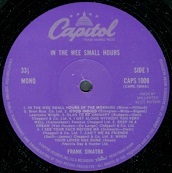
Another 1970s pressing, one that trumpets “MONO,” which is technically true, I suppose, but this is sourced from the DUOPHONIC tapes, summed to mono. It’s horrible sounding, and please note that, to my knowledge, ONLY very early copies with “-1” matrices have this sort of sound. Later pressings are true mono from dry tapes. (Click album cover for audio.) Thanks to Ian Bradley for physically mailing this LP to me, thus making it available for use on this website.

LAST NIGHT WHEN WE WERE YOUNG:
Interesting to note that on the 1991 edition of the Walsh CD, this song (only this song) is mastered “dry.”
•1991 Walsh-mastered CD: 10 Last Night When We Were Walsh-NORM_01-03.mp3
•1998 UK boxed set CD: 10 Last Night When We Were UK98-GAIN_01-05.mp3
Above: D4 EP, courtesy Stevelucille.
Above: D8 pressing, courtesy “Arkoffs.”
Above: N12 12” LP.
Above: circa 1985 G5 12” SM-series mono 10-song LP, mastered by Gene Thompson.
Above: 2012 unlicensed EU DMM LP release, courtesy “colormesinatra.”
Above: 1998 UK CD set, courtesy “DJ Wilbur.”
SAMPLE AUDIO CLIPS
All clips posted here (with one 3-second exception) mirror those freely available via iTunes. To access the 90-second iTunes free samples, click
“View,” then “View in iTunes.”

Transitional clips:
•D1 10” LP to 1998 UK CD: WSHD1TenInch-UKCD.wav
•D1 10” LP to N12 12” LP: WSHD1TenInch-N12.wav
•1984 UK “Dell” LP (wet) to 1998 UK “Dell” CD (Dry): WSHUK84-UK98.wav
•1991 Walsh CD (wet) to 1998 UK CD (Dry): WSHWalsh91-UK98.wav
•1998 UK CD to 1998 Norberg USA CD: WSHUK98-Norberg.wav
BONUS CLIPS:
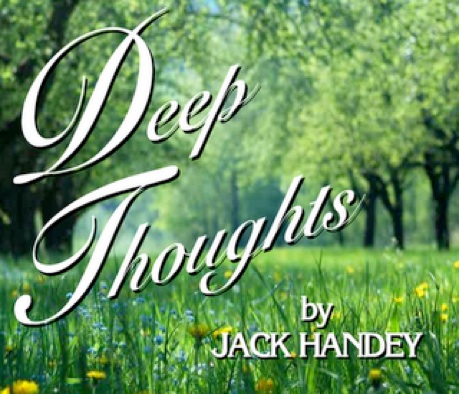
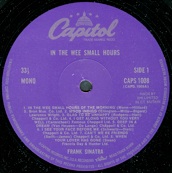

Here is a clip of my -2/-4 pressing of the 1970s UK LP (with the alternate cover), with an EQ boost to compensate for what strikes me as a rolled-off top end: 01 InTheWeeSmallHoursOfTheMorningMossEQd-GAIN_01-03.wav “Off the shelf,” this LP has wonderful bass and midrange, but not much in the treble department. With some tweaking, though, it’s a good-sounding, mono, 16-track LP.
Recorded March 1, 1954; February 8, 16, 17, and March 4, 1955
Arrangements: Nelson Riddle
Conducted by Nelson Riddle, Bill Miller
Producer: Voyle Gilmore; Mixer: John Palladino
Original Release: April 1955
Above: 2011 EU unauthorized Black Coffee Records CD release, courtesy “moops.” This is a clone of the 1998 UK CD, with the addition of mild compression.
Above: D2 12” LP, courtesy “Bozburn”
Sinatra fan bferr1 was kind enough to send along a clip from his early 12” promo LP, which definitely improves upon the sound of the 10” LP heard in the previous clip. Click on the label photo to listen.

Above: D16 LP, courtesy “Blackie”
Above: 2014 Capitol/UME Hi-Rez download (downsampled to 16/44.1)
Above: 2014 Capitol/UME Hi-Rez download (downsampled to 16/44.1)
I’m no Jack Handey, but I do have some thoughts on this album’s assorted releases.
First off, I must say that John Palladino did a heck of a job recording this album, and fully deserved his NARAS award for outstanding engineering. These arrangements cry out “warmth” and “smoothness,” and should be mastered in a way that conveys those impressions. That said, I think that, very unusually, the “D” pressings do not always best serve the recordings, as their treble seems to add a slight edginess to the top end that may not put the music in its best light. That sort of thinking goes against my usual thought processes, but as I listen to the assorted N, D, and other pressings, the tone of the D cuts is not always my favorite, and I think that I often find myself preferring a more “covered” treble sound, such as on the better of the N pressings -- at least on the string-based tunes. I do think that the green-label and the “D” cuts are superior on the “small group” selections (such as “I’ll Be Around), perhaps because of the greater need to hear the sparkle of the cymbals and guitar.
In the end, I don’t think that any release absolutely “nails it,” but I do think the 1998 UK boxed set CD is very nice. There’s an oddness in the treble that lends it a bit of “digitalness,” but it’s quite good nevertheless, and I am comfortable recommending it highly. Similarly, the currently available (October, 2014) hi-resolution downloads available from ProStudioMasters.com (officially licensed from Capitol/Universal) are excellent, despite the slight clipping-off of the beginning of track eleven.
In the LP world, it’s tough to find a truly near mint pre-1962 USA pressing these days, and while those pressings are quite good, I’m not sure I’d call them “great.” The 2014 Capitol/UMe release is excellent (one glitch aside), and provides the first high-quality USA LP release of this title in decades, so is well worth picking up. It is arguably the best LP release this title has had.
Final conclusion? I guess that the 2014 LP and 1998 UK CD are, all things considered, the best versions out there “as is.” (I’d place the 2014 LPs tone on a par with the 1998 UK CD, and slightly above the 2014 download version.) I have a slight preference for the 1998 disc, but regardless: My advice? Pick up the LP (preferred) or hi-res download (not quite as nice) while you can. To paraphrase SH.TV’s “colormesinatra,” this is the first decent-sounding 16-track reissue of this album in the US for over 50 years, so don’t let the parade pass you by. Vintage LP copies? Don’t dismiss the N copies out of hand. OK with doing a little tweaking? Consider the 1970s Harry Moss LP.
LOTS of versions are about 85% on their way to being “audiophile” quality, and while none of them quite makes it all the way to the goal, many versions sound very good. The trick is to avoid the wet-tape versions and the releases with sub-par tone. Hopefully the clips provided can assist you in finding your own favorite among many good choices.
Matthew Lutthans
February 26, 2014, revised October, 2014

October 7, 2014 - Capitol/UMe high-resolution digital download via online outlets worldwide, using correct, dry tapes for all 16 tracks. The beginning of track 11 is slightly clipped off, but mastering is otherwise good.
NOTE: The above 2014 download version has the opening of “I’ll Be Around slightly clipped off. Here is a brief clip that starts with the 2014 download, switches to the un-clipped 1970s UK LP, then repeats/alternates these examples three more times.
Above: 2014 Capitol/UMe LP, courtesy SHTV’s “AxeD”
Above: 2014 Capitol/UMe LP, courtesy SHTV’s “AxeD”
NOTE: The 2014 LP version has the opening of “I’ll Be Around slightly clipped off. Here is a brief clip that starts with the 2014 download, switches to the un-clipped 1970s UK LP, then repeats/alternates these examples three more times.
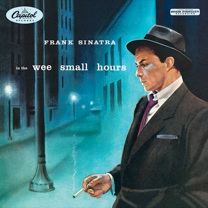
October 7, 2014 - Capitol/UMe LP, mastered by Capitol’s Ron McMaster, using correct, dry tapes for all 16 tracks. As with the HD download, the beginning of track 11 is slightly clipped off, but mastering is otherwise quite good.

